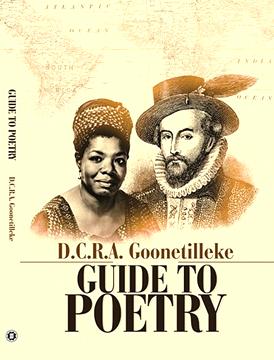
Guide to Poetry by Prof Emeritus DCRA Goonetilleke, Department of English, University of Kelaniya, addresses an important requirement in the scholarship of English in Sri Lanka, at a time the focus of teaching English has been confused by several negative developments in the areas of curricula development and undergraduate and postgraduate research at various academic institutions.
While it functions as a guide to the poetry components in the GCE O/L and A/L syllabuses, it presents an in-depth account of the linguistic and aesthetic developments that English poetry underwent due to various social, cultural, political, and economic changes that Britain as well as the rest of the world experienced over a period of 500 to 600 years, and identifies its texture influenced by specific literary and aesthetic movements, known as, Elizabethan, Augustan, Victorian, Modern, Postcolonial, etc. introducing the inspiration it drew from the traditional, classical and modern developments in rhetoric and prosody.
Therefore, it is anticipated that this handsome book would help to save the energies of the enthusiastic learners and the amateur teachers engaged in studying English Literature. The value of the book lies in the precision of its focus as a pedagogical reference material.
The poems Prof Goonetilleke has selected from the respective syllabuses to illustrate the progress of English poetry through the several periods of time contribute to a comprehensive package for any enthusiast in mastering its fundamentals.
His analyses of the popular and traditional ballads, sonnets by Shakespeare, songs by Donne, political satire by Dryden, Romantic poems by Blake, Wordsworth, Keats, Shelley, and Byron, Victorian poems by Tennyson, Rossetti, and Hopkins, and Modern English poems by Yeats, Sassoon, and Owen help to enlighten the reader on the radical changes English poetry underwent in accordance with the numerous social upheavals Britain experienced in politics and commerce over the centuries.
He takes the readers into new domains of poetry through his analyses of Postcolonial poetry where he focuses on Zulfikar Ghose and Dom Moraes, Kamala Das, and Nissim Ezekiel from India, David Rubadiri and Gabriel Okara from Africa, Derek Walcott from the West Indies, and Anne Ranasinghe, Yasmine Gooneratne, and Richard de Zoysa from Sri Lanka.
His analyses of the American poems by Emily Dickinson, Edward Arlington Robinson, Stephen Crane, Robert Frost, Edna St. Vincent Millay, Gwendolyn Brooke, Sylvia Plath, Maya Angelou, and Bob Dylan add excitement to the exploration by introducing new trends of thinking that emerged under globalization.
The representations of European poetry made through his analyses of the poems by Wislawa Szymborska from Poland and Jacque Prevert from France enhances the understanding further, shedding light on various culture-specific circumstances that inspire poetry.
All in all, these meticulous analyses are thorough in their attention to the themes, settings, imagery, and techniques, and make the pursuit of poetry a refreshing intellectual exercise. They provide a clear direction to the teachers and learners in organizing the patterns of their poetry analyses.
Based on these virtues of the book that I experienced while reading it, and the comfort I enjoyed while introducing the analyses of the Sri Lankan poems in it to a group of students of my own, I recommend this book to both GCE O/L and A/L learners of English Literature as well as students in universities and technical colleges who read English as a subject – and their teachers as well as readers who wish to visit or revisit enjoyable poems of the past and present.
E.A. Gamini Fonseka, PhD
Senior Professor in English Department of English & Linguistics
University of Ruhuna
